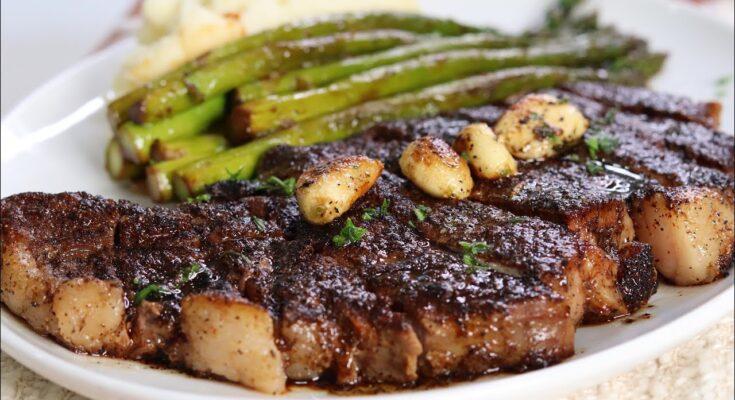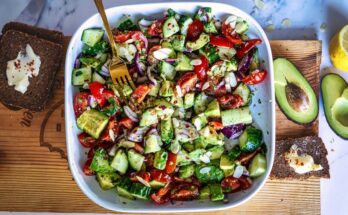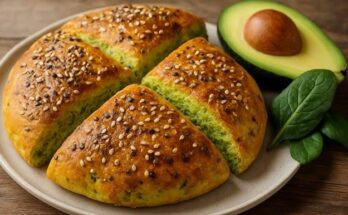Steak Recipe: Cooking the perfect steak at home doesn’t have to be intimidating. With the right approach, equipment, and techniques, you can prepare a restaurant-quality steak in your own kitchen. Let’s dive into this comprehensive step-by-step guide.
Selecting the Perfect Steak
Types of Steak Cuts
Choosing the right cut is the foundation of a good steak. Some popular cuts include:
- Ribeye: Known for its rich marbling, this cut is juicy and full of flavor, making it a favorite among steak lovers.
- Sirloin: A leaner option that still offers excellent taste and tenderness, perfect for those who prefer less fat.
- Filet Mignon: The most tender cut, often prized for its melt-in-your-mouth texture and subtle flavor.
Factors to Consider When Choosing a Steak
- Thickness: A thicker steak (about 1.5-2 inches) ensures even cooking and allows for a great sear.
- Marbling: Look for steaks with fine white fat streaks, as these enhance flavor and tenderness.
- Grass-fed vs. Grain-fed: Grass-fed beef has a more robust flavor, while grain-fed offers a sweeter, buttery taste.
Preparing Your Steak
Bringing the Steak to Room Temperature
Before cooking, take the steak out of the fridge and let it sit for 30-60 minutes. This step ensures even cooking, as a cold steak can cook unevenly, leading to an overdone exterior and an undercooked interior.
Seasoning Options
The way you season your steak greatly influences its flavor. Here are some popular approaches:
- Simple Salt and Pepper: A classic choice that lets the steak’s natural flavor shine.
- Dry Rubs: A mix of spices like garlic powder, paprika, and cayenne for added depth.
- Marinades: Ideal for tougher cuts, marinades tenderize the meat while infusing it with flavor.
Equipment You’ll Need
- Cast Iron Skillet or Grill: Essential for achieving a proper sear or char.
- Meat Thermometer: Ensures precise doneness, leaving no room for guesswork.
Cooking Techniques for the Perfect Steak
Pan-Searing Method
Pan-searing is perfect for achieving a golden-brown crust.
- Heat a cast iron skillet over high heat until smoking.
- Add a tablespoon of oil with a high smoke point, like canola or avocado oil.
- Sear the steak for 2-3 minutes on each side until a crust forms.
- Reduce heat to medium and cook to your desired doneness, flipping occasionally.
Grilling Method
Grilling adds a smoky flavor that many find irresistible.
- Preheat your grill to high heat.
- Place the steak directly on the grates and sear for 2-3 minutes per side.
- Move the steak to a cooler part of the grill and finish cooking to your preferred doneness.
Sous Vide Method
For precision cooking, sous vide is unbeatable.
- Vacuum-seal the steak with seasonings.
- Cook in a water bath set to your desired doneness (e.g., 129°F for medium-rare).
- Sear the steak quickly in a hot skillet to develop a crust.
Achieving the Desired Doneness
Understanding Doneness Levels
Here’s a quick guide to internal temperatures:
- Rare: 120-125°F (cool red center)
- Medium-Rare: 130-135°F (warm red center)
- Medium: 140-145°F (pink center)
Using a Meat Thermometer
Insert the thermometer into the thickest part of the steak. Avoid touching bone or fat to get an accurate reading.
Resting and Slicing the Steak
Why Resting Matters
Resting the steak for 5-10 minutes after cooking allows the juices to redistribute, keeping the meat juicy and flavorful.
How to Slice Against the Grain
To maximize tenderness, always slice the steak against the grain. This shortens the muscle fibers, making each bite more tender.
Side Dishes to Pair with Steak
Classic Sides
- Mashed Potatoes: Creamy, buttery, and the perfect comfort food.
- Creamed Spinach: Rich and velvety, it’s a steakhouse classic.
Light and Fresh Options
- Grilled Vegetables: Asparagus, zucchini, and bell peppers add a fresh balance.
- Side Salads: A crisp Caesar or mixed greens salad complements the richness of the steak.
Tips for Enhancing Flavor
Finishing Touches
- Butter Basting: Add butter, garlic, and thyme to the skillet and spoon over the steak for extra flavor.
- Herb Garnishes: Chopped parsley or rosemary adds freshness and color.
Sauces for Steak
- Chimichurri: A zesty Argentinian sauce made with parsley, garlic, and olive oil.
- Peppercorn Sauce: Creamy and slightly spicy, it’s a steakhouse staple.
Common Mistakes to Avoid
- Overcooking or Undercooking: Always use a thermometer to avoid guesswork.
- Skipping the Resting Stage: Cutting the steak too early results in lost juices.
- Not Seasoning Adequately: Don’t be shy with salt and pepper; it’s key to enhancing flavor.
FAQs about Steak Recipe
1. What is the best cut of steak for grilling?
The best cuts for grilling are Ribeye, T-bone, and New York Strip due to their marbling and thickness, which contribute to juiciness and flavor.
2. How long should I cook a steak for medium rare?
For a 1-inch thick steak, cook it on high heat for about 3-4 minutes per side. Always use a meat thermometer to check that the internal temperature has reached 130-135°F for the perfect medium rare.
3. Should I season my steak before cooking?
Yes, seasoning your steak with salt and pepper before cooking enhances the natural flavors. For best results, season your steak about 30 minutes before grilling to allow the salt to penetrate and flavor the meat.
4. Can I cook a steak in a frying pan?
Absolutely! A cast iron skillet is ideal for cooking steak on the stovetop. Heat the skillet until it’s very hot, add a small amount of oil, and cook your steak to the desired doneness.
5. How do I know when my steak is done?
Using a meat thermometer is the most reliable method. Here are the temperatures for doneness: 120-125°F for rare, 130-135°F for medium rare, 140-145°F for medium, 150-155°F for medium well, and 160-165°F for well done.
6. What should I do after cooking my steak?
Let your steak rest for about 5 to 10 minutes after cooking. This allows the juices to redistribute throughout the meat, making it juicier and more flavorful when cut.
7. Is it necessary to marinate steak?
Marinating is not necessary, but it can enhance flavor and tenderness, especially for less tender cuts like flank or skirt steak. A good marinade typically contains acid (like vinegar or lemon juice), oil, and herbs/spices.
8. What’s the best way to achieve a charred exterior on a steak?
High heat is key. Whether grilling, broiling, or pan-searing, make sure your cooking surface is very hot before adding your steak. This high heat creates a flavorful crust by caramelizing the outside of the steak.
9. Can I reuse leftover steak?
Yes, leftover steak can be sliced and used in salads, sandwiches, or as a protein boost in other dishes. Be sure to store leftovers in the refrigerator and consume them within 3 days.
10. How can I make my steak more tender?
Proper cooking and slicing techniques can help. Always slice steak against the grain, and consider using a meat tenderizer or marinade for tougher cuts.
Conclusion
Cooking steak at home is a rewarding culinary adventure. By selecting the right cut, using proper techniques, and avoiding common pitfalls, you can master the art of steak cooking. Don’t hesitate to experiment and make it your own!



